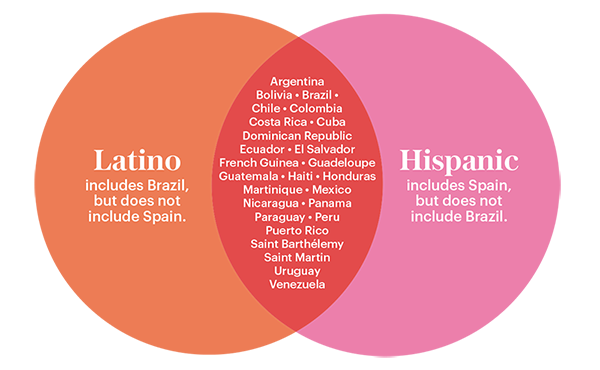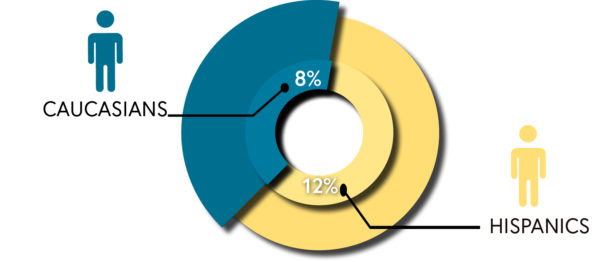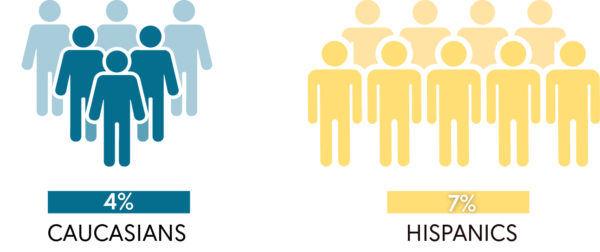You may not think that people who identify as Hispanic or Latino/Latina are at risk for sunburns or skin cancer. They are at risk, though, and some are at high risk.
By Maritza I. Perez, MD
While it’s true that people with very light skin have the highest risk for skin cancer, people of color can develop skin cancer, too. People who identify as Hispanic and Latino, in fact, can be any race or mix of races and have any color of skin. It all started when Christopher Columbus, an Italian, set sail from Spain with Spanish crew members and arrived in 1492 at various islands in the “New World,” which at that time was mainly the Caribbean. Spaniard Ponce de León joined him on his next voyage, looking for gold and that mythical fountain of youth and landed in what is now Puerto Rico.
These voyages led the way for European colonization, and soon waves of immigrants started arriving in Central and South America. These included Italians, Germans and Portuguese. Others arrived from Africa and Asia. The immigrants mixed with the indigenous people, and Latin America became a melting pot. So the genetics for light skin and risk for sun damage were woven into the culture, along with the genetics for darker skin and greater natural protection against sun damage. Here, some important, surprising facts about Hispanics and skin cancer.
First, What’s the Difference Between Hispanic and Latino/Latina?
These terms, while often used interchangeably, are slightly different. In general, Hispanic refers to people with origins in Spanish-speaking countries. Latino/Latina refers more specifically to people with roots in Latin America. They mostly overlap, but not completely.

Worse Prognosis for Melanoma
In the past two decades, melanoma incidence has risen by 20 percent among Hispanics. While fewer Hispanic people are diagnosed with melanoma than Caucasians, a higher percentage of Hispanics who are diagnosed with melanoma die from it.
Present with Thicker Tumors

Cancers Have Regional Involvement

Tumors Have Distant Metastasis (Spread)

What About Nonmelanoma Skin Cancers?
A small study in San Diego looked at nonmelanoma skin cancer (basal cell carcinoma and squamous cell carcinoma, the two most common types of skin cancer) among Hispanic, Asian and Caucasian patients. While the incidence was much higher in Caucasians, the researchers found that the Hispanic patients were diagnosed at a significantly younger age (62 versus 70) and had more skin cancers in the “central face” area.
“If we look at the numbers, nonmelanoma skin cancer has a much higher incidence than melanoma but it is less reported on. Due to a lack of awareness on the risks of nonmelanoma skin cancers, many patients of color also receive a diagnosis at a late stage of disease,” said Dr. Perez.
Indoor Tanning and the Hispanic Community
Some Hispanic people have very light skin and want to tan, and they may mistakenly think they’re not at risk for skin cancer. In one study, white Hispanics were 2.5 times more likely to have used a tanning bed in the past year than white non-Hispanics. More than 419,000 cases of skin cancer in the U.S. each year are linked to indoor tanning.
The Bottom Line
Projections show that Hispanics will make up nearly 30 percent of the U.S. population by 2060. Hispanic people are the largest population without health insurance in the U.S. Nearly 20 percent lack medical insurance, compared with about 10 percent of the general population. Also, nearly 24 percent of Hispanics in the U.S. live under the poverty level. Lack of access to medical care is a problem. As reported in the literature, and in my own experience, Hispanics are and will be at risk of developing and dying from skin cancer unless they become more aware of the risk and take greater steps to protect themselves from the sun.
Maritza I. Perez, MD, founder and director of ADVANCED AESTHETICS in New Canaan, Connecticut, is an associate clinical professor of dermatology at the Icahn School of Medicine at Mount Sinai and an attending physician in the Mount Sinai Health System hospitals in New York City. Dr. Perez is also a senior vice president of The Skin Cancer Foundation and a member of its Amonette Circle.






